Vizio Thin+Light CT15: Something New and Edgy
by Vivek Gowri on February 14, 2013 9:00 AM EST- Posted in
- Laptops
- Intel
- IPS
- Ivy Bridge
- Vizio
- Ultraportable
- Ultrabook
The display is actually what every single mid-to-high end 15” notebook should aim to ship with. It’s a matte 15.6” 1080p IPS panel made by LG, and it looks awesome. It actually shares the same panel as the HP Envy 15, with a close variant of this panel being used by Sony with the SE series that Jarred reviewed as well as ASUS in the new UX51. It's not necessarily perfect, but it's so far ahead of the most other laptops panels that it may as well be.
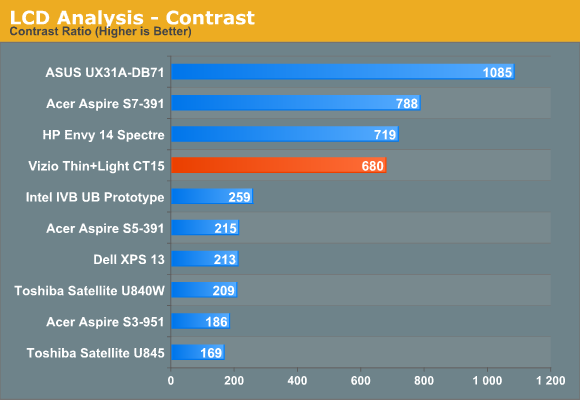
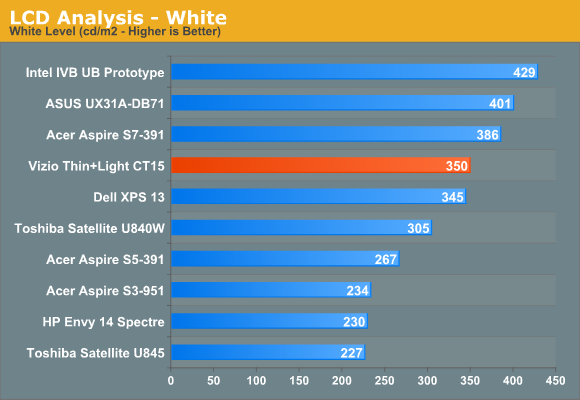
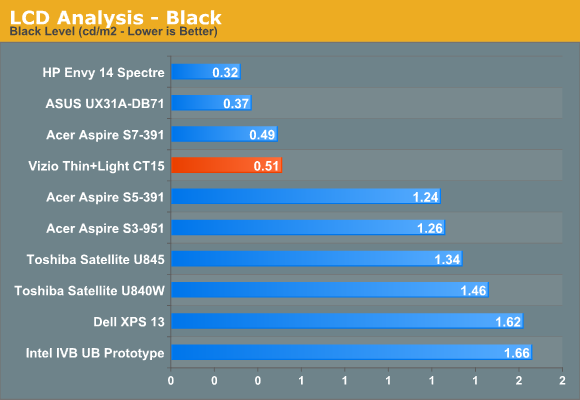
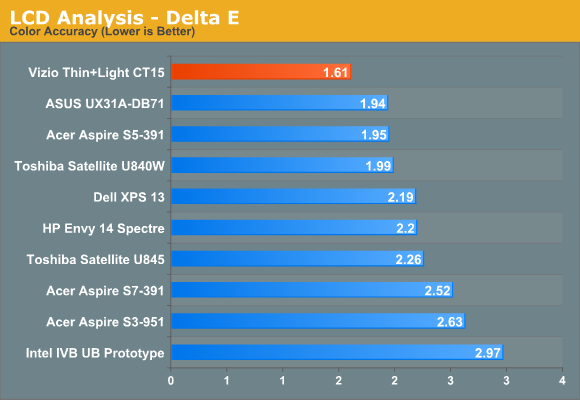
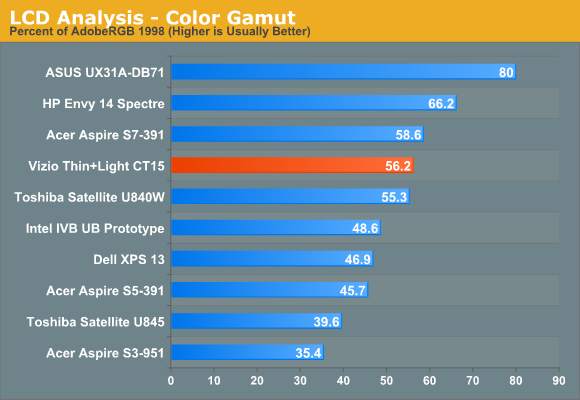
It doesn’t necessarily have the best contrast ratio, though at nearly 700:1 it’s certainly good, but the backlight is strong (350 nit maximum brightness), the matte finish is awesome, and color reproduction is very good. 1080p at 15.6” is essentially the perfect pixel density for a good amount of screen real estate, without making everything too small for comfortable viewing. It’s just really pleasing to the eye. I love it, and it makes up for a lot of the other flaws—every time the keyboard gets on my nerves, I remember how fantastic this display is. It’s just that compelling.
Now, it’s obviously not a touchscreen, and how much that bothers you depends on how much you value melding the traditional clamshell form factor with a touchscreen, and how much that impacts your Windows 8 experience. For me personally, touchscreens stop being useful on notebooks larger than 13”. Any larger than that, and my typical viewing distance is far enough away for it to be a bit uncomfortable to reach out and touch the screen. Not that I couldn’t do it if I wanted, but it’s an actual effort with larger notebooks where it’s almost second nature to use the touchscreen for navigation on 11.6” systems. The line for me is at 13”—anything larger than that, and the amount I use the touchscreen in day-to-day use goes down significantly.
Even though I didn’t particularly miss the touchscreen with the Vizio, all Vizio PCs going forward will have touchscreen displays, including the next revision of the Thin+Light line that we’ve already had a chance to play with. From our brief interaction with it, it seemed like a high quality display, though I’m not sure how much the user experience will change. Portable Windows 8 systems are still undergoing rapid form factor iterations, and manufacturers are still working on finding the sweetspots in the range. I’m not sure that touchscreens have value in large notebooks, but I’m willing to be proven wrong on this.










55 Comments
View All Comments
rangerdavid - Thursday, February 14, 2013 - link
Soldered-on is pretty standard in these thin form-factors. Yes, 6 or 8 would be nice, but removable means thicker in most cases. No pun intended. Wait, no; intended.blueboy11 - Friday, February 15, 2013 - link
LOL! Yeah, the damned soldered unremovable RAM that should've been upgraded to 8GB in the first place! What the hell where they thinking in the first place? Oh wait, they weren't!!MobiusStrip - Sunday, February 17, 2013 - link
Just because a rip-off has become standard doesn't mean we should accept it.Apple has led the way in degrading its computers with soldered-in RAM, glued-together chassis and now shitty laptop drives in its desktop computers. We should not give them or any other manufacturer a free pass on this crap.
PeteH - Wednesday, March 6, 2013 - link
I honestly don't think manufacturers are doing things like soldering down RAM to rip people off, I think they're doing it because that's the only way to get the form factor.The problem is that consumers continue to endorse trading flexibility for pretty industrial design (based on what they buy). Manufacturers are just giving the consumers what they want, and it's hard to fault them for it.
Ninhalem - Thursday, February 14, 2013 - link
When do you need more than 4 GB of RAM? If this is used as a non-gaming notebook I don't think you will ever need more than 4 GB for a regular notebook (the HD 4000 already guarantees that this isn't a gaming oriented notebook).I'm running a desktop at the moment with only 4 GB of RAM with about 5 applications open (including Adobe running a big file) and only using about 1.7 GB.
Actually this notebook is a slam dunk for me. I've been crawling the internet for a notebook with these specs for my father to use as a research (history) tool when he goes overseas.
I just don't think the perception of 4GB is not enough is viable here.
halo37253 - Thursday, February 14, 2013 - link
Tell me what you need more then 4gb of ram for?I have 6GB of RAM in my main system and have never had a program fill it other then p95 while stressing. Really unless the user is running VM crazy or is going crazy in some adobe program I think the user is more then set with 4gb.
RAM does not make your PC faster if you don't need it, no one using a laptop like this with no GPU to load advance compute or even games onto. Though even for gaming you don't need more then 4gb.
4GB in my gaming HTPC and 6GB in my main system, both always has RAM left.
I would rather have them take the 256gb SSD out of this laptop and toss in a 128gb m-sata chip and toss in a HDD for user storage. For SSD you only need some apps and OS on your SSD. Pretty much all user files in the c:\users\yourname can be moved onto the HDD for more storage. Do the same thing with my laptop and desktop, but with sata SSD not msata. No point to have movies, music, games installed onto the SSD.
themossie - Thursday, February 14, 2013 - link
Chrome can easily use more than 4 gigs of ram with a minimal set of extensions.6 gigs used right now (2 more cached) out of 8 gb on my old Arrandale Studio XPS 16. Notepad++ and two web browsers with 50 tabs open, flash disabled and minimal extensions.
How could I upgrade to a machine with less RAM? Many people can sacrifice processing power for battery life and form factor, but not RAM - especially given how cheap it is these days.
themossie - Friday, February 15, 2013 - link
Also - 4 years ago (early 2009), the entry-level config of the earliest version of my laptop (Core 2 Duo) came with 4 gigs of ram.It had the same $1100 MSRP at the time, though definitely not an ultrabook - weighing 2.5 lbs more:-)
seapeople - Sunday, February 17, 2013 - link
Browsers allocate far more memory than they actually use, and are programmed to trim this allocation with virtually no impact to performance once the memory is needed elsewhere in the system.So even though your Chrome may routinely report a use of 4-6 gb on your 8 gb system, if you only had a 4 gb system then Chrome would likely purr along just the same while using only 2-3 gb of RAM. Perhaps once every four days when you switch over to tab number 80 it will take 2 seconds for Chrome to pull up the picture at the bottom of the page on this tab, which you would only even notice if you switched to that tab and immediately hit Ctrl-End.
Not to mention that hibernating a system with 8 gb of RAM will take significantly longer than one with 4 gb of RAM...
cbf - Thursday, February 14, 2013 - link
Software Development.Visual Studio, local ASP.NET server (for debugging), and connection to large databases.
Also, certain CAD work. Normally one would say you need a workstation class laptop with Quadra or FirePro onboard, but frankly Intel HD4000 graphics is pretty close to where mobile Quadra or FirePro was a few years ago, and works OK with a lot of CAD packages now.